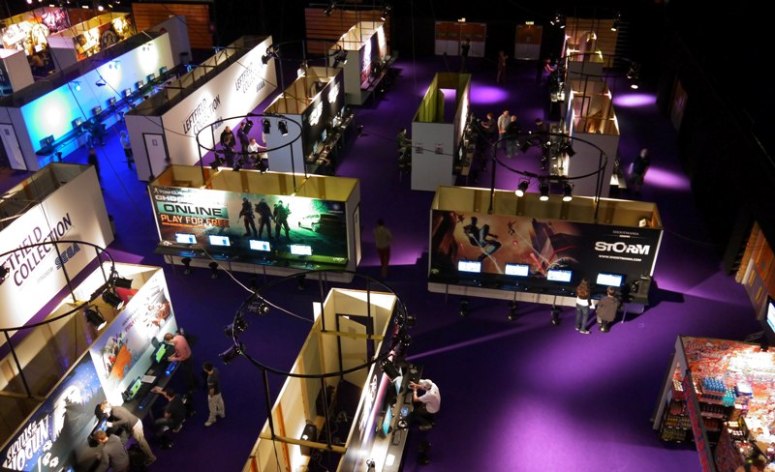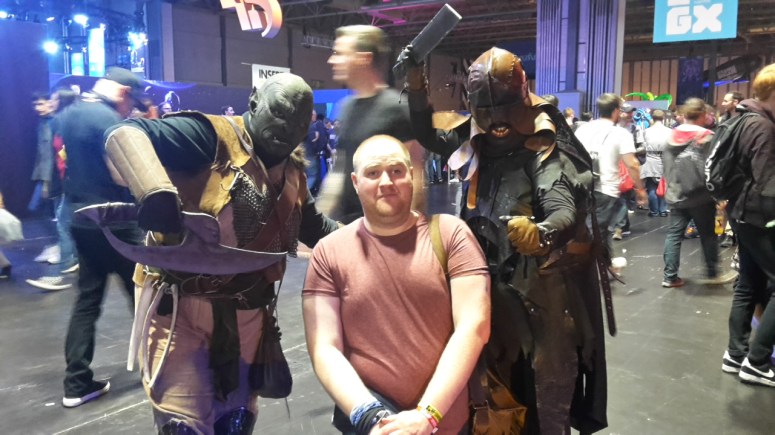I started out in the games industry in 2011 as a production intern and quickly went into marketing after that. Since then I’ve attended over 20 events as an exhibitor both in the UK and abroad. In that time there’s been a big growth in the number of exhibiting opportunities available along with changes in how publishers and developers showcase their games.
So, here are some of the things I’ve learned over the years that should be of benefit to indie developers. Also, as with all internet advice, your mileage may vary.
Decide Where To Go

Getting your game out there is important, but events may not be the best way to do it. From my experience consumer shows do not always translate to sales and as you’re answering to a budget you’ll be looking for a return on the investment. To get that you’ll need objectives.
Here’s some examples of what you could look to get out of an event:
- I want press and influencers to cover my game.
- I need people to play test my game and provide feedback.
- I just want people to play it and tell their friends.
- I have a promotion on and I want players to buy my game today.
You can have as many goals as you think you can handle and you can set appropriate KPIs against these.
Creating an event strategy to tackle these objectives is not a simple task. To decide what events could fulfill your goals you’ll need to do your own research. Look up developer reviews and opinions of the events your considering. Gather relevant data from your social media, website and previous titles to see if there are any audiences or regions that your game might be more successful in at an event. Take stock of what you have that could be used to reduce costs. Is there a potential event in your home region? Do you have banners and hardware ready to use?
Decided on an event? Great. Now here’s a rough method to calculate the value of that event.
(Total Event Duration [mins] ÷ Length of Demo [mins])
x
Number of Screens
= Total Engagements
The math above doesn’t account for spectators or multiplayer titles (you could use Max Players instead of screens). Equally, it’s a best case scenario that assumes you’ll be at full capacity from start to finish. However, it provides a cold, hard number to benchmark against. For instance, you could divide your event budget by the Total Engagements for a Cost Per Engagement. If you have another campaign like a beta sign-up on social media or a storefront advertising opportunity that looks like it could give better results for less money then you’d have reason to consider going with that.
However, all the estimates above can’t account for the other benefits of attending an event – press coverage, player feedback, business networking and social fun. When you’re deciding what events to go to you’ll need to place a value on these and have a plan for them even if the ROI is incalculable.
How To Get People Playing
Once you’ve signed up to attend a show make sure you comply with any requests for assets from the organizers. Having your game on their site and in the show guide is an essential step before you’ve even begun. Get your ‘Elevator Pitch’ nailed too. Don’t be afraid to use genre-terms or compare it to other titles if that helps get the message across. Use whatever messaging feels genuine and in line with the tone of your game.
Consider having an attract mode so players can see your game in action from a distance before they sit down. This will draw in people during any lull in activity as they’ll get a taste of exactly what they’ll be playing. If your game is a slower experience then a trailer could also work in lieu of gameplay.
It’s great to have a crowd round your game and if you do get one you’ll want to keep them involved. Competitions (eg, time trials or score attack) and giveaways help keep people invested and draw others in. Schedule events throughout the day to keep people coming back for more.
If you’re creating artwork (or a 3rd party is) then make sure you know the exact context of use for each piece. Will screens be covering the bottom 20% of your big wall? If so, keep that area free of anything important. Items like roller banners are great but if people are standing all around them then most of it will be hidden so key info needs to go at the very top. Some teams love monitor toppers because they’re in the eyeline of both players and spectators and don’t get obscured when people spectate or do over-the-shoulder filming. Hanging banners are luxury branding investment that you should really only consider if you have something BIG to say or an established brand presence people will already make a beeline for.
Flyers and cards are cheap promotional items to make but from my experience too many of them end up in the bin or littering someone else’s stand. If you’ve got merch going spare then use it. However, if you’re making it for an event I would choose making a limited number of a high-value item for challenges and social competitions over cheaper goods to be given out to everyone. People will treasure and engage with something that they earned more so than something they were just given.
Meet Press & Influencers

Press and influencers are never under any obligation to cover your game just because you were at the show. It’s entirely possible to be at a huge event and not get featured in a single video or article. There is no sure-fire way to dodge that risk but here are steps to mitigate it.
If you already have contacts then make sure you’re reaching out to them to see if they want to see you game / do an interview / get some lunch. Whatever’s your style and makes you feel comfortable. Be sure to post on social media that you’re attending and available for interview. Try to give some fun topics you’re willing to talk about.
Have a PR agency? Make sure they’re working to get you interviews and demo sessions. If you don’t have any agency contracted for your game you can still consider hiring one specifically for the show. This is a big help if you’re working overseas and need to get linked up with local press.
Whether you know everyone or nobody in the journalistic world, always contact the event organizers to get the press list. This will help you find out who is coming and usually how to contact them. Failing this, you can talk to people on the day (which you should be doing anyway). In the modern gaming world everyone could be a potential superfan for your title.
Managed to arrange for media to come play your game? Great! Now here’s one thing some devs and publishers have mishandled over the years. Make sure you have space for them. Do not kick a member of the public off your game because an influencer has rocked up (booked or unbooked). I’ve seen this happen not just to members of the public but industry people too. Instead, where possible, have another screen that you can use. If this is on your stand then make sure it’s kept off whenever you’re expecting someone. If your game is on PC or mobile then a laptop or tablet is a great idea, plus you can move to a dedicated press area for a quieter time.
Get Useful Feedback
Games expos are not the best place to get player feedback. The majority of people may only play your game for 15 minutes. They may have a hundred other things they want to do at the show and they certainly weren’t expecting to be grilled for their opinions. However, all this doesn’t mean you can’t garner valuable feedback.
Some players will be shy about saying anything beyond “It’s fun” when pressed for an opinion. On the flipside others will tell you exactly what they think is wrong and give you specific instructions on how they would resolve it. At some point, in the history of game events, a consumer probably nailed the problem and solution. However, it’s far more likely you’ll get told something entirely unhelpful.
One way to get more feedback out of shy folks and useful feedback out of people with plenty to give is to have specific feedback goals and to anonymize your collection process.
First you need to have goals with what you’re wanting to test and to decide on these before you attend. Is it the tutorial? The graphics? A aspect of the gameplay loop? Decide on this and then get a few questions ready on the subject. You can still go with a single “tell us what you liked/didn’t like” question if you want to cover a lot of ground but be prepared for vague answers.
The second step is to integrate this survey into your stand activity. The basic way to do this is to have a clipboard with pen and paper and ask your questions there. Point it out to players but don’t hover over them as they fill it out or go through it as soon as they’re done, it needs to feel anonymous for them. If you can integrate the survey to come up at the end of your game demo instead then that’s even better. Giving some merch in exchange for feedback is a bonus that most people don’t expect. Feel free to do this but make sure it’s something you have enough of to last the entire event.
If these suggestions aren’t practicable for you then there’s another way to get feedback. If you’ve got the patience for it then watch your players closely. Don’t disrupt them unless they’re clearly struggling or you’ve got bugs to navigate them past.
Meet New People

The first step on the path to networking and meeting new people is getting business cards made. Assuming your game or studio is a creative venture then make cards that reflect this. Don’t be afraid to let your personality and your game’s style shine through. If you’re someone who believes business cards are dead then just make sure your Twitter handle or Facebook page is easily typed after seven pints.
Keep an eye out for parties and networking events around the show you’re going to. Official event Twitter accounts and hashtags are the best way to find out about these. Some parties sell out in minutes whilst others may have tickets on the door. Research what ones you want to go to in advance and buy the tickets as soon as you can.
If you’re not flying solo then be sure to take time to stroll the show floor, play games and talk to people. Remember that networking is about making friends and meeting people. Don’t go out there to just meet someone who can finance your game or give you a new job. Transactional networking like that isn’t something the games industry does.
Not sure what to talk to people about? Try discussing games.
Quantify The Result
Knowing the success of an event is important, even if you’re one of the lucky few who hasn’t got a bottom line to answer to. It’s better to have information beyond “I got a lot of people playing” or “kids loved it” so you can make judgements about the future and adjust your event plan accordingly.
If you want to track how many people played your game then get a tally counter (clicker). They’re cheap and easy to use, just click every time someone is engaged with your game. That could be watching someone play or checking out your artwork as well as playing it themselves.
Tracking press can be a case of waiting for any articles or videos to be published. Make sure you ask about when it might be published at the end of any interview or demo session as it’s useful to know. Don’t be afraid to chase (politely) if quoted deadlines have slipped.
If you’ve been actively sharing your social channels with consumers at a show then check those for new followers or engagements during the event. Signups for mailing lists are a great way to grow a community so long as you give people an incentive to join at the show and clear, legally compliant info on how you’ll be using their personal data.
Everyone’s Doing It Differently

There’s plenty of competition philosophies in games, from production methodologies to launch date debates. This extends to events. Some big publishers retain an international presence at all consumer events whilst others have pulled out of certain regions to focus on others. Another strategy I’ve seen has been a focus on regular community ‘roadshow’ event.
Things like hired actors, big photo-ops (think Star Wars: Battlefront’s Tie Fighter or Total War: Warhammer’s giant spider), and massive giveaways will wax and wane with each event. They’re things that get implemented on a product by product basis. Sometimes they’ll do great things for a title, other times it’s a big loss on the balance sheet.
The only trend I’ve seen consistently in both indie and AAA spaces is the move towards publishers and developers grouping up under partners to reduce costs at consumer events. That includes development partners like Unity or Unreal as well as platform holders. Other smaller schemes like The Leftfield Collection and Tentacle Collective at EGX or PAX’s Indie Megabooth allow developers of all sizes to group together.
All this partnering up means branding is integrated and shared, there’s less individual product identity. However, the reduction in costs and man-hours this provides makes it a very attractive thing to do. The party that might lose out here are the event organizers.
I’ll make only two predictions about games events of the future:
- We’ll all be trying more and more to drive engagement beyond sales as events often prove far more effective at nurturing communities rather than nabbing pre-orders.
- More events will follow the BlizzCon Virtual Ticket model and have a digital offering to increase attendees even if they aren’t attending in a physical space.
That’s all from me. Do let me know what your thoughts are. I’ll now hand you over to some other useful talks and write-ups on gaming events:
You Suck At Showcasing Your Game – Nicolae Berbece
Preparing For & Surviving Gaming Expos As An Indie – Meredith Hall
Indie Exhibitor Lessons Learned: Mommy’s Best Games’ PAX Story – Nathan Fouts
